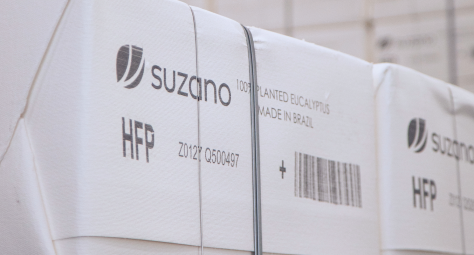sobre o que você deseja falar?


perguntas, sugestões ou problemas técnicos envolvendo a plataforma

informações sobre a empresa





GRI Dimension
EnvironmentalGRI Code
305-4GRI Code
305-5Stakeholder
PlanetTCFD
Related IndicatorsCommitments to Renewing Life
To reduce its emissions intensity, Suzano continuously invests in modernization projects that include efficiency in industrial processes, reduction in fossil fuel consumption, reduction in energy use, and purchase of more efficient equipment, among others. Different areas and operations of the company map technologies and develop studies to submit and approve projects promoting the reduction of greenhouse gas (GHG) emissions.
To learn more about these initiatives and projects, visit the indicators: “Climate change at Suzano” and “Management of GHG emissions in forestry, industrial and logistics operations”.
The following information is available in the tables below:
| 2022 | 2023 | 2024 | |
|---|---|---|---|
| tCO₂e/t | tCO₂e/t | tCO₂e/t | |
|
Scopes 1 and 2¹ |
0.2111 |
0.2107 |
0.2046 |
|
Scopes 1, 2 and 3 partial²³ |
0.3429 |
0.3389 |
0.3154 |
|
Scopes 1, 2 and 3 complete²⁴ |
1.7241 |
1.7240 |
1.5985 |
| 2022 | 2023 | 2024 | |
|---|---|---|---|
| tCO₂e/R$ | tCO₂e/R$ | tCO₂e/R$ | |
|
Scopes 1, 2 and 3 partial²³ |
90,743.12 |
109,314.93 |
92,936.12 |
|
Scopes 1, 2 and 3 complete²⁴ |
456,306.51 |
556,158.46 |
471,016.77 |
In 2024, Suzano acquired two plants in the United States: Pine Bluff, Arkansas, and Waynesville, North Carolina. These operations were integrated into Suzano's activities in October 2024, and the greenhouse gas emissions from these units were included in the company's inventory.
This acquisition aims to make Suzano a major supplier in the United States of paper used in the production of Liquid Packaging Board, a material widely used in the North American food market. Moreover, the acquisition will allow Suzano to expand its presence in the paper cup segment.
Although the new plants are currently more carbon-intensive than Suzano's other operations, they will be included in the company's global decarbonization strategy. In line with its global mitigation strategy, Suzano plans to increase the efficiency of these units in the coming years, making them less carbon-intensive.
In 2024, Suzano had a year of increased production with the start-up of the new Ribas do Rio Pardo unit and the entry of the two new American units into its operational control. Absolute direct emissions (Scope 1) also increased, influenced mainly by the increase in stationary emissions due to the start-up of the Cerrado Project (5%). In addition, the 42% increase in the electricity emission factor (national grid) increased our Scope 2 emissions by 13%.
Thus, despite the 6% increase in absolute emissions (scope 1 + 2), the overall intensity factor fell by 3% (scope 1 + 2/production), signaling an increase in efficiency in our operation. Because of these points, the intensity of our emissions (scopes 1 and 2) per ton of production was 0.2046 tCO₂e/t.
As Suzano's new foreign units have significantly impacted our target of more than 5%, it was necessary to recalculate the base year of our Commitment to Renew Life, which aims to reduce scope 1 and 2 emissions by 15% per tonne of production by 2030, compared to the base year of 2015.
As a result, our indicator for the Commitment to Renew Life for 2015 went from 0.2133 to 0.2241 tCO₂e/t, and our target went from 0.1813 to 0.1905 tCO₂e/t. To find out more, visit the Suzano Sustainability Center.
The revenue (in thousands of reais) for 2023 was 39,755,575 BRL, and for 2024, it was 47,403,282 BRL.
The intensity indicator decreased in 2024, as consolidated net revenue grew by 19%, impacted by the company's good performance and increased pulp volume, while total emissions (scope 1 + 2 + 3) remained stable (+1%).
To learn more about emissions data, go to the "Greenhouse gas (GHG) emissions and methodology" indicator. For net revenue indicators, visit this link. See the "Climate change at Suzano" indicator for more information on mitigation initiatives.
Footnote:
• The Greenhouse Gas Protocol: A Corporate Accounting and Reporting Standard, by the World Resources Institute (WRI) and the World Business Council for Sustainable Development (WBCSD) (2004);
• Guides, guidelines, and calculation tools from the Getulio Vargas Foundation's Brazilian GHG Protocol Program (PBGHGP) (2023);
• IPCC Guidelines for National Greenhouse Gas Inventories, from the Intergovernmental Panel on Climate Change (IPCC, 2006);
• Calculation Tools for Estimating Greenhouse Gas Emissions from Pulp and Paper Mills, do National Council for Air and Stream Improvement (NCASI - 2005).
Following the principles for carrying out GHG inventories, we have considered, whenever possible, measurement data and emission factors closest to the local reality. We tried to avoid assumptions and secondary data, emphasizing primary data from our operations, which allows us to have accurate and reliable monitoring of the company's decarbonization practices. The GHG emissions accounting for the Greenhouse Gas Emissions Inventory published in the Brazilian GHG Protocol Program Public Register is regularly verified/audited by an independent third party.